check engine light FIAT TALENTO 2020 Owner handbook (in English)
[x] Cancel search | Manufacturer: FIAT, Model Year: 2020, Model line: TALENTO, Model: FIAT TALENTO 2020Pages: 236, PDF Size: 4.86 MB
Page 166 of 236
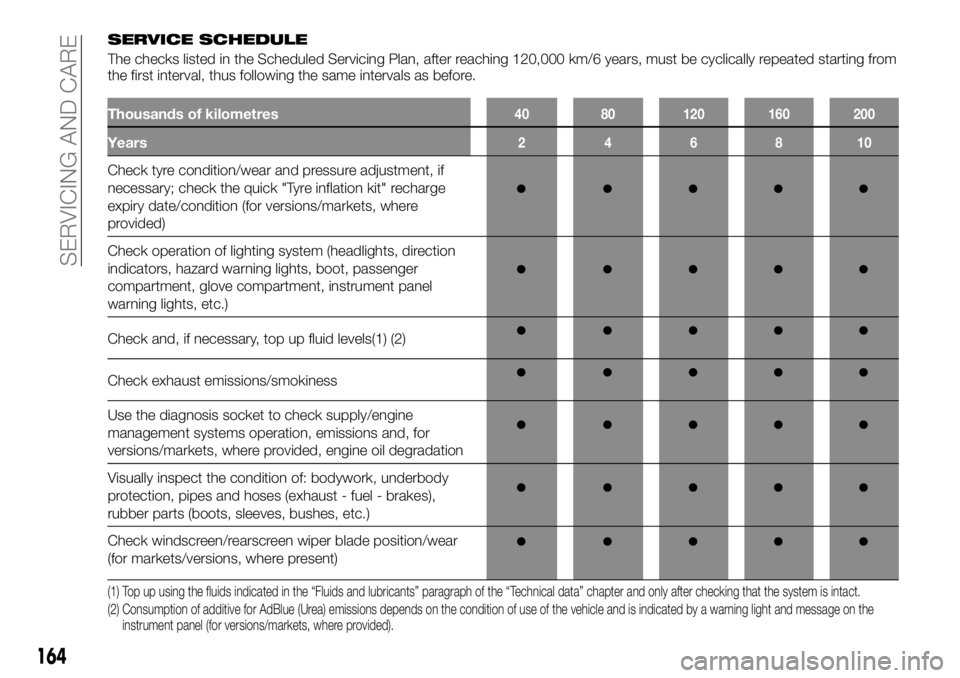
SERVICE SCHEDULE
The checks listed in the Scheduled Servicing Plan, after reaching 120,000 km/6 years, must be cyclically repeated starting from
the first interval, thus following the same intervals as before.
Thousands of kilometres40 80 120 160 200
Years246810
Check tyre condition/wear and pressure adjustment, if
necessary; check the quick "Tyre inflation kit" recharge
expiry date/condition (for versions/markets, where
provided)
Check operation of lighting system (headlights, direction
indicators, hazard warning lights, boot, passenger
compartment, glove compartment, instrument panel
warning lights, etc.)
Check and, if necessary, top up fluid levels(1) (2)
Check exhaust emissions/smokiness
Use the diagnosis socket to check supply/engine
management systems operation, emissions and, for
versions/markets, where provided, engine oil degradation
Visually inspect the condition of: bodywork, underbody
protection, pipes and hoses (exhaust - fuel - brakes),
rubber parts (boots, sleeves, bushes, etc.)
Check windscreen/rearscreen wiper blade position/wear
(for markets/versions, where present)
(1) Top up using the fluids indicated in the “Fluids and lubricants” paragraph of the “Technical data” chapter and only after checking that the system is intact.
(2) Consumption of additive for AdBlue (Urea) emissions depends on the condition of use of the vehicle and is indicated by a warning light and message onthe
instrument panel (for versions/markets, where provided).
164
SERVICING AND CARE
Page 167 of 236
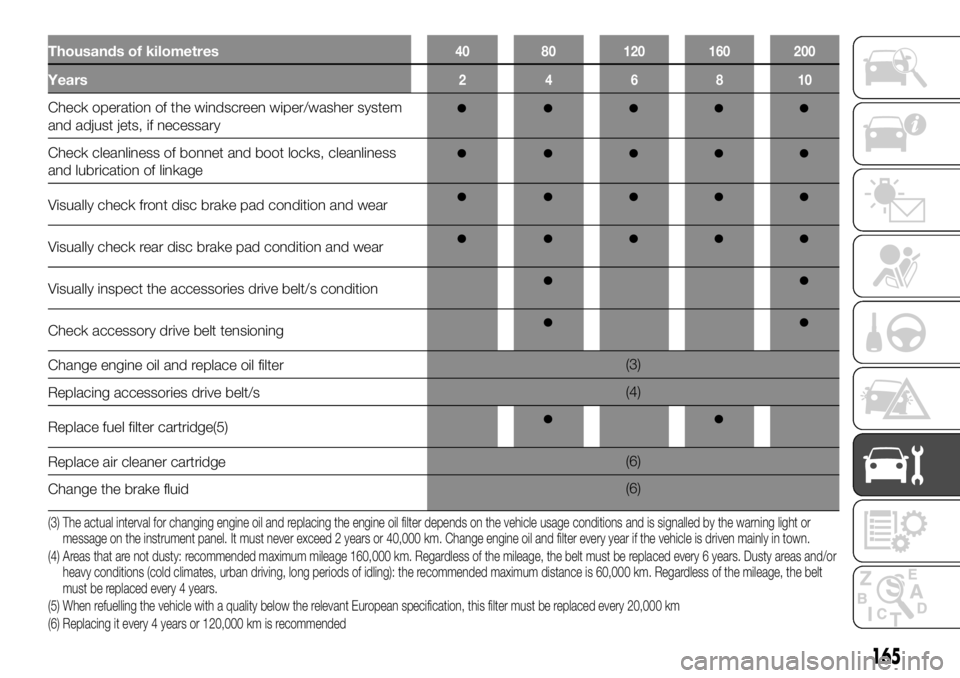
Thousands of kilometres40 80 120 160 200
Years246810
Check operation of the windscreen wiper/washer system
and adjust jets, if necessary
Check cleanliness of bonnet and boot locks, cleanliness
and lubrication of linkage
Visually check front disc brake pad condition and wear
Visually check rear disc brake pad condition and wear
Visually inspect the accessories drive belt/s condition
Check accessory drive belt tensioning
Change engine oil and replace oil filter(3)
Replacing accessories drive belt/s(4)
Replace fuel filter cartridge(5)
Replace air cleaner cartridge(6)
Change the brake fluid(6)
(3) The actual interval for changing engine oil and replacing the engine oil filter depends on the vehicle usage conditions and is signalled by the warning light or
message on the instrument panel. It must never exceed 2 years or 40,000 km. Change engine oil and filter every year if the vehicle is driven mainly in town.
(4) Areas that are not dusty: recommended maximum mileage 160,000 km. Regardless of the mileage, the belt must be replaced every 6 years. Dusty areas and/or
heavy conditions (cold climates, urban driving, long periods of idling): the recommended maximum distance is 60,000 km. Regardless of the mileage, the belt
must be replaced every 4 years.
(5) When refuelling the vehicle with a quality below the relevant European specification, this filter must be replaced every 20,000 km
(6) Replacing it every 4 years or 120,000 km is recommended
165
Page 170 of 236
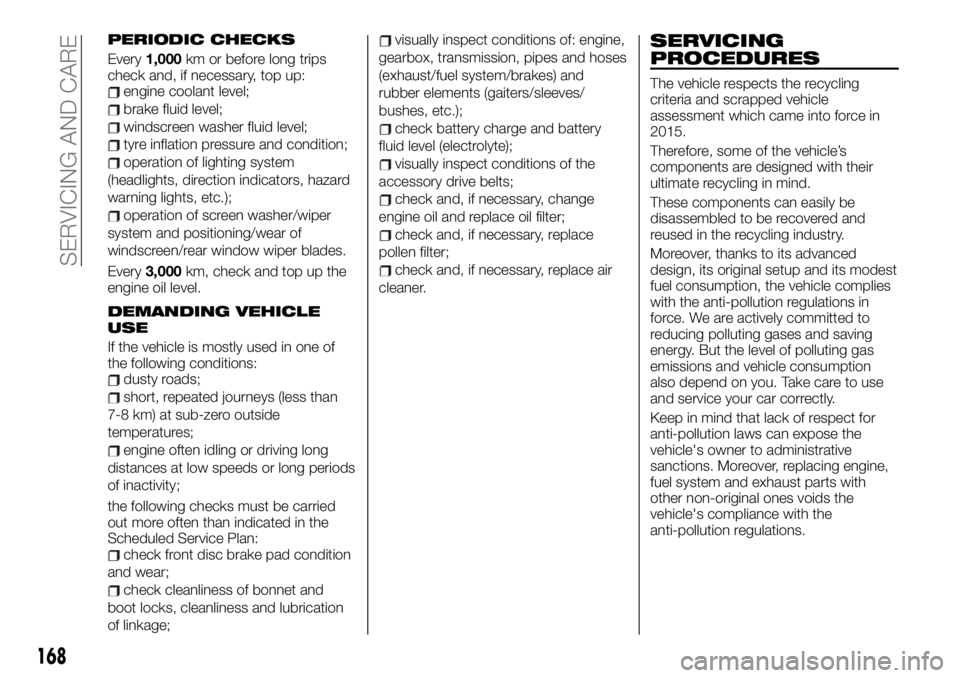
PERIODIC CHECKS
Every1,000km or before long trips
check and, if necessary, top up:
engine coolant level;
brake fluid level;
windscreen washer fluid level;
tyre inflation pressure and condition;
operation of lighting system
(headlights, direction indicators, hazard
warning lights, etc.);
operation of screen washer/wiper
system and positioning/wear of
windscreen/rear window wiper blades.
Every3,000km, check and top up the
engine oil level.
DEMANDING VEHICLE
USE
If the vehicle is mostly used in one of
the following conditions:
dusty roads;
short, repeated journeys (less than
7-8 km) at sub-zero outside
temperatures;
engine often idling or driving long
distances at low speeds or long periods
of inactivity;
the following checks must be carried
out more often than indicated in the
Scheduled Service Plan:
check front disc brake pad condition
and wear;
check cleanliness of bonnet and
boot locks, cleanliness and lubrication
of linkage;
visually inspect conditions of: engine,
gearbox, transmission, pipes and hoses
(exhaust/fuel system/brakes) and
rubber elements (gaiters/sleeves/
bushes, etc.);
check battery charge and battery
fluid level (electrolyte);
visually inspect conditions of the
accessory drive belts;
check and, if necessary, change
engine oil and replace oil filter;
check and, if necessary, replace
pollen filter;
check and, if necessary, replace air
cleaner.
SERVICING
PROCEDURES
The vehicle respects the recycling
criteria and scrapped vehicle
assessment which came into force in
2015.
Therefore, some of the vehicle’s
components are designed with their
ultimate recycling in mind.
These components can easily be
disassembled to be recovered and
reused in the recycling industry.
Moreover, thanks to its advanced
design, its original setup and its modest
fuel consumption, the vehicle complies
with the anti-pollution regulations in
force. We are actively committed to
reducing polluting gases and saving
energy. But the level of polluting gas
emissions and vehicle consumption
also depend on you. Take care to use
and service your car correctly.
Keep in mind that lack of respect for
anti-pollution laws can expose the
vehicle's owner to administrative
sanctions. Moreover, replacing engine,
fuel system and exhaust parts with
other non-original ones voids the
vehicle's compliance with the
anti-pollution regulations.
168
SERVICING AND CARE
Page 173 of 236
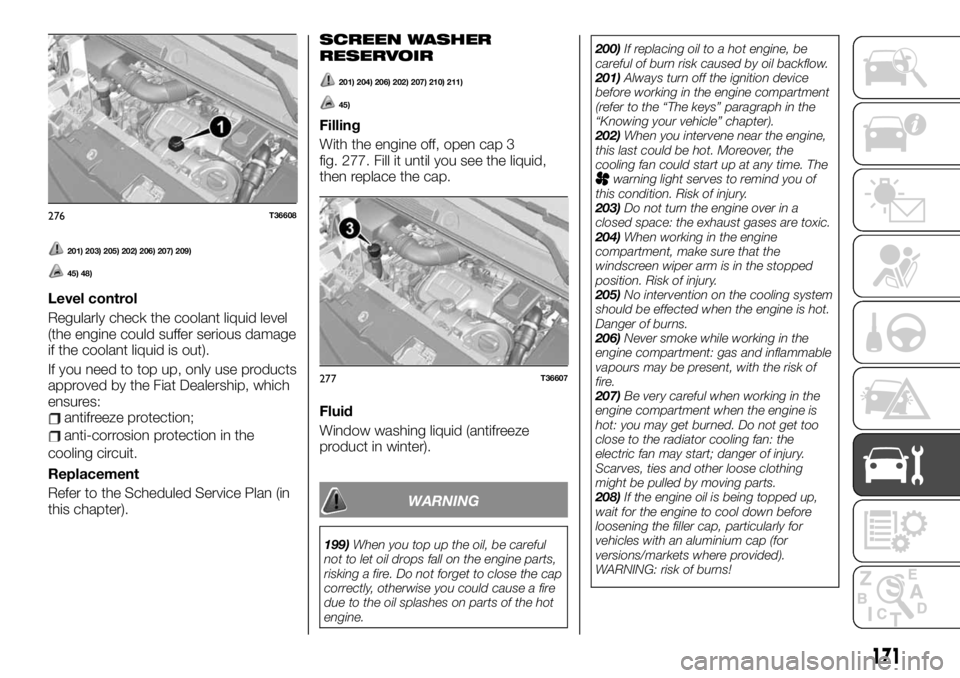
201) 203) 205) 202) 206) 207) 209)
45) 48)
Level control
Regularly check the coolant liquid level
(the engine could suffer serious damage
if the coolant liquid is out).
If you need to top up, only use products
approved by the Fiat Dealership, which
ensures:
antifreeze protection;
anti-corrosion protection in the
cooling circuit.
Replacement
Refer to the Scheduled Service Plan (in
this chapter).
SCREEN WASHER
RESERVOIR
201) 204) 206) 202) 207) 210) 211)
45)
Filling
With the engine off, open cap 3
fig. 277. Fill it until you see the liquid,
then replace the cap.
Fluid
Window washing liquid (antifreeze
product in winter).
WARNING
199)When you top up the oil, be careful
not to let oil drops fall on the engine parts,
risking a fire. Do not forget to close the cap
correctly, otherwise you could cause a fire
due to the oil splashes on parts of the hot
engine.200)If replacing oil to a hot engine, be
careful of burn risk caused by oil backflow.
201)Always turn off the ignition device
before working in the engine compartment
(refer to the “The keys” paragraph in the
“Knowing your vehicle” chapter).
202)When you intervene near the engine,
this last could be hot. Moreover, the
cooling fan could start up at any time. The
warning light serves to remind you of
this condition. Risk of injury.
203)Do not turn the engine over in a
closed space: the exhaust gases are toxic.
204)When working in the engine
compartment, make sure that the
windscreen wiper arm is in the stopped
position. Risk of injury.
205)No intervention on the cooling system
should be effected when the engine is hot.
Danger of burns.
206)Never smoke while working in the
engine compartment: gas and inflammable
vapours may be present, with the risk of
fire.
207)Be very careful when working in the
engine compartment when the engine is
hot: you may get burned. Do not get too
close to the radiator cooling fan: the
electric fan may start; danger of injury.
Scarves, ties and other loose clothing
might be pulled by moving parts.
208)If the engine oil is being topped up,
wait for the engine to cool down before
loosening the filler cap, particularly for
vehicles with an aluminium cap (for
versions/markets where provided).
WARNING: risk of burns!
276T36608
277T36607
171
Page 225 of 236
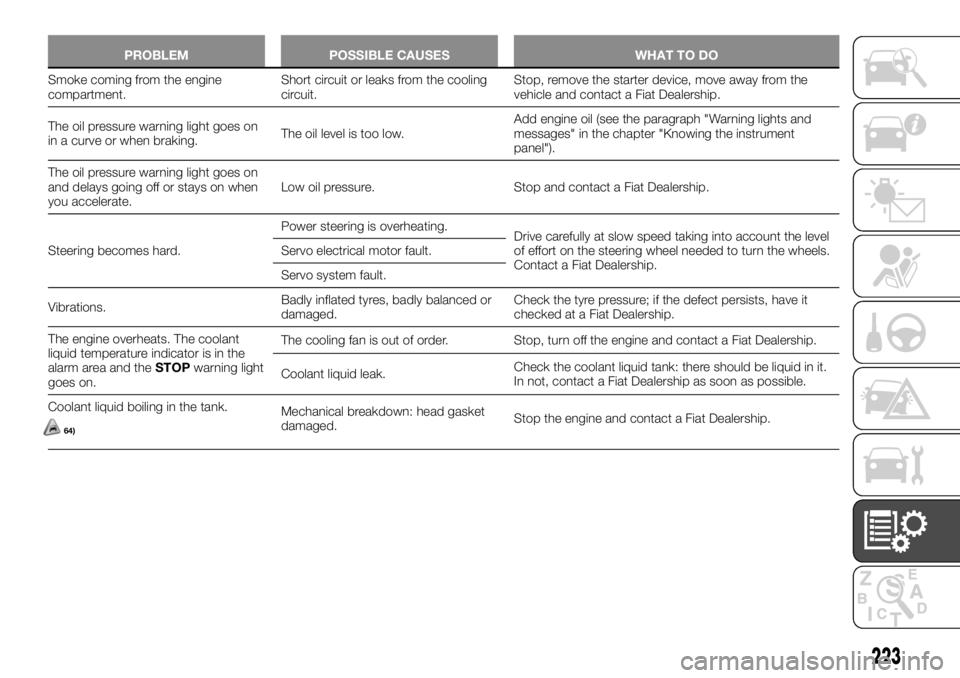
PROBLEM POSSIBLE CAUSES WHAT TO DO
Smoke coming from the engine
compartment.Short circuit or leaks from the cooling
circuit.Stop, remove the starter device, move away from the
vehicle and contact a Fiat Dealership.
The oil pressure warning light goes on
in a curve or when braking.The oil level is too low.Add engine oil (see the paragraph "Warning lights and
messages" in the chapter "Knowing the instrument
panel").
The oil pressure warning light goes on
and delays going off or stays on when
you accelerate.Low oil pressure. Stop and contact a Fiat Dealership.
Steering becomes hard.Power steering is overheating.
Drive carefully at slow speed taking into account the level
of effort on the steering wheel needed to turn the wheels.
Contact a Fiat Dealership. Servo electrical motor fault.
Servo system fault.
Vibrations.Badly inflated tyres, badly balanced or
damaged.Check the tyre pressure; if the defect persists, have it
checked at a Fiat Dealership.
The engine overheats. The coolant
liquid temperature indicator is in the
alarm area and theSTOPwarning light
goes on.The cooling fan is out of order. Stop, turn off the engine and contact a Fiat Dealership.
Coolant liquid leak.Check the coolant liquid tank: there should be liquid in it.
In not, contact a Fiat Dealership as soon as possible.
Coolant liquid boiling in the tank.
64)
Mechanical breakdown: head gasket
damaged.Stop the engine and contact a Fiat Dealership.
223
Page 233 of 236
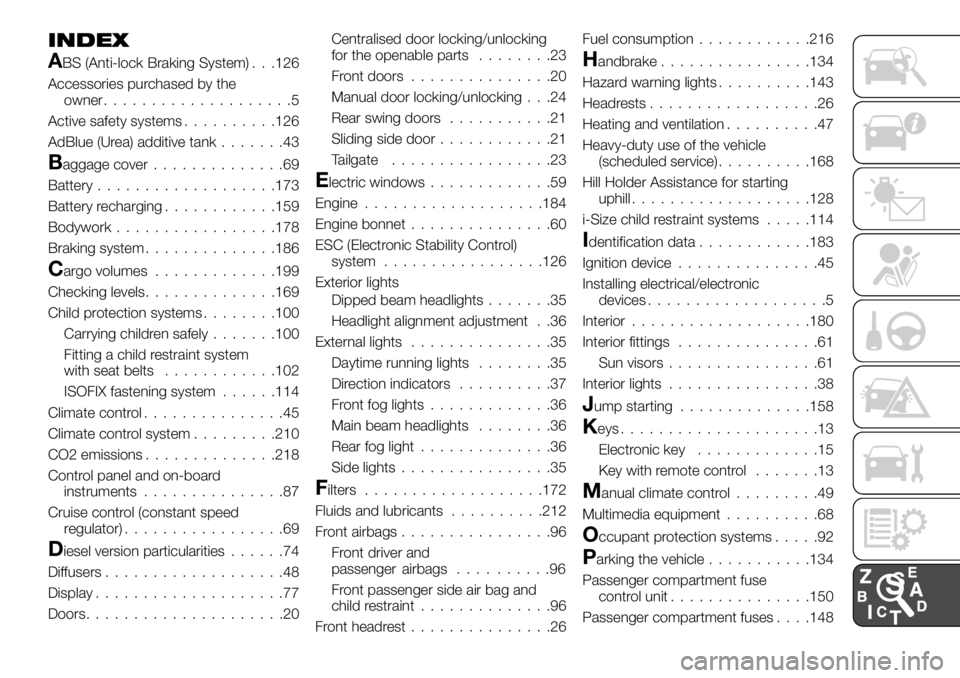
INDEX
ABS (Anti-lock Braking System) . . .126
Accessories purchased by the
owner....................5
Active safety systems..........126
AdBlue (Urea) additive tank.......43
Baggage cover..............69
Battery...................173
Battery recharging............159
Bodywork.................178
Braking system..............186
Cargo volumes.............199
Checking levels..............169
Child protection systems........100
Carrying children safely.......100
Fitting a child restraint system
with seat belts............102
ISOFIX fastening system......114
Climate control...............45
Climate control system.........210
CO2 emissions..............218
Control panel and on-board
instruments...............87
Cruise control (constant speed
regulator).................69
Diesel version particularities......74
Diffusers...................48
Display....................77
Doors.....................20Centralised door locking/unlocking
for the openable parts........23
Front doors...............20
Manual door locking/unlocking . . .24
Rear swing doors...........21
Sliding side door............21
Tailgate.................23
Electric windows.............59
Engine...................184
Engine bonnet...............60
ESC (Electronic Stability Control)
system.................126
Exterior lights
Dipped beam headlights.......35
Headlight alignment adjustment . .36
External lights...............35
Daytime running lights........35
Direction indicators..........37
Front fog lights.............36
Main beam headlights........36
Rear fog light..............36
Side lights................35
Filters...................172
Fluids and lubricants..........212
Front airbags................96
Front driver and
passenger airbags . . . . ......96
Front passenger side air bag and
child restraint..............96
Front headrest...............26Fuel consumption............216
Handbrake................134
Hazard warning lights..........143
Headrests..................26
Heating and ventilation..........47
Heavy-duty use of the vehicle
(scheduled service)..........168
Hill Holder Assistance for starting
uphill...................128
i-Size child restraint systems.....114
Identification data............183
Ignition device...............45
Installing electrical/electronic
devices...................5
Interior...................180
Interior fittings...............61
Sun visors................61
Interior lights................38
Jump starting..............158
Keys.....................13
Electronic key.............15
Key with remote control.......13
Manual climate control.........49
Multimedia equipment..........68
Occupant protection systems.....92
Parking the vehicle...........134
Passenger compartment fuse
control unit...............150
Passenger compartment fuses. . . .148